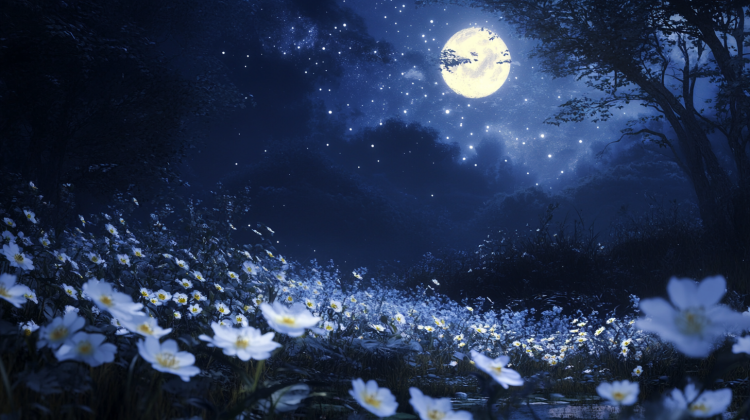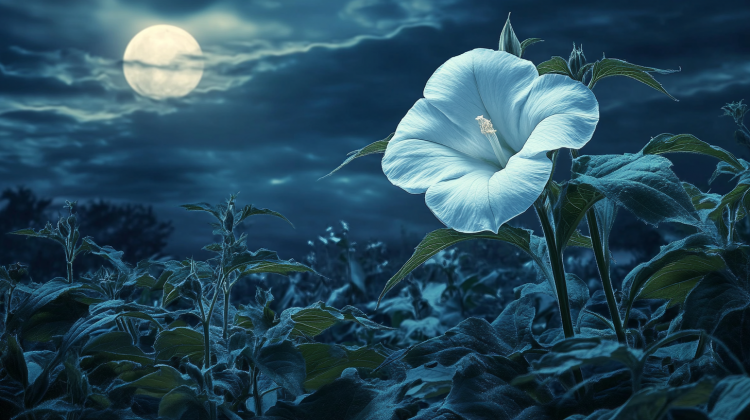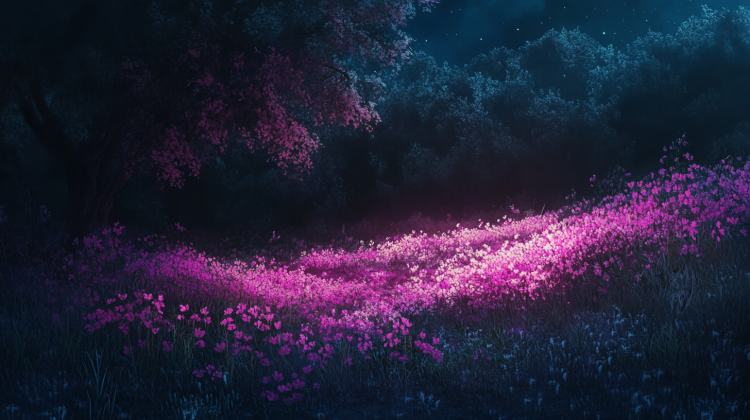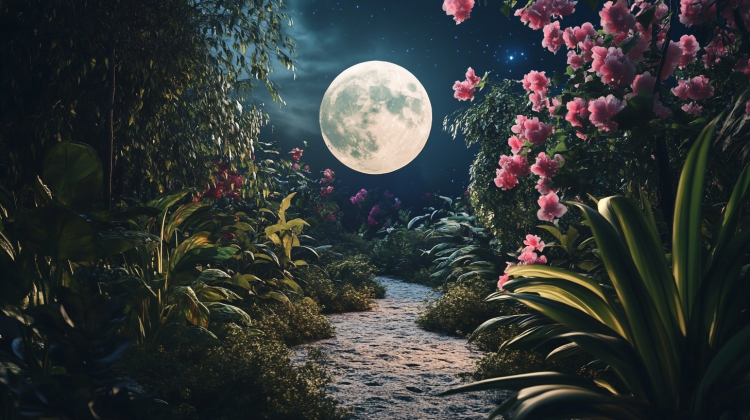

A moon garden is a magical outdoor space designed to come alive under the soft glow of the moonlight. By choosing plants with silvery foliage, white blooms, and fragrant flowers, you can create a serene and enchanting garden that shines at night. Here’s a step-by-step guide to growing your own moon garden and a list of plants that thrive in this nighttime oasis.
Imagine stepping into your garden on a warm evening, surrounded by glowing white blooms, silvery foliage, and the soft, soothing scents of night-blooming flowers. A moon garden transforms your outdoor space into a tranquil retreat, where nature’s beauty is illuminated under the moonlight. Unlike traditional gardens that rely on vibrant daytime colors, a moon garden focuses on subtle elegance, with plants chosen to reflect and amplify the light of the moon.
Moon gardens are visually captivating— but they also engage your other senses. The delicate fragrances of night-blooming flowers like jasmine or evening primrose fill the air, creating a calming atmosphere perfect for unwinding. Additionally, the gentle rustling of ornamental grasses or the soft hum of nocturnal pollinators adds a layer of natural charm to the experience. These elements make moon gardens ideal for quiet reflection, late-night gatherings, or simply enjoying the serenity of your own backyard.
Designing a moon garden is also an opportunity to explore the interplay of light, texture, and scent in your landscaping. By combining plants with varying heights, shapes, and shades, you can create a layered effect that captures the moon’s glow from different angles. Whether you have a small patio or a sprawling yard, a moon garden can be customized to fit your space, bringing a touch of enchantment to your evenings.
What Is a Moon Garden?
A moon garden is a special type of garden designed to be enjoyed at night, taking advantage of plants that reflect moonlight, release nighttime fragrances, or attract nocturnal pollinators. Unlike traditional gardens that rely on colorful blooms to shine during the day, moon gardens focus on plants with white or pale flowers, silvery foliage, and soothing scents that become most vibrant after sunset. These elements create a tranquil, ethereal atmosphere, perfect for evening relaxation or moonlit gatherings.
The concept of a moon garden is rooted in the interplay of light and nature. The soft, silvery hues of certain plants reflect the glow of the moon, creating a luminous effect that enhances the garden’s beauty in low light. Additionally, night-blooming flowers, such as moonflowers or night phlox, open their petals in the evening, releasing sweet, calming fragrances that fill the night air. This combination of visual and sensory appeal makes a moon garden an enchanting escape after a long day.
Beyond its aesthetic and sensory benefits, a moon garden also supports the ecosystem by attracting nocturnal pollinators like moths, bats, and even certain species of bees. These creatures play an essential role in maintaining biodiversity, and a moon garden provides a welcoming habitat for them. Whether you have a sprawling backyard or a cozy balcony, creating a moon garden allows you to connect with nature in a unique way, celebrating the beauty of the night.


How to Plan Your Moon Garden
Creating a moon garden requires thoughtful planning to ensure it shines under moonlight and provides a peaceful retreat. Follow these detailed steps to design a garden that captures the beauty of the night.
1. Choose the Right Location
- Moonlight Exposure: Select an area that receives ample moonlight. Open spaces, patios, or areas near windows where you can enjoy the view at night work well. If your yard is shaded or blocked by trees, you can supplement with soft garden lighting.
- Visibility: Place your moon garden in a spot that is easily accessible and visible from your outdoor seating or a window. This ensures you can enjoy its beauty even from indoors.
- Proximity to Pathways or Seating: Consider positioning your moon garden near a seating area or pathway where you’ll spend time relaxing in the evening.
2. Prepare the Soil
- Soil Testing: Test your soil to understand its pH and nutrient levels. Most moon garden plants prefer well-drained soil, so amend with compost or sand if necessary.
- Enrichment: Add organic matter such as compost or aged manure to improve fertility and promote healthy plant growth.
- Weed Removal: Remove weeds and debris from the area to create a clean slate for planting.
3. Select Plants for Moonlight and Fragrance
- Focus on White or Pale Blooms: Choose plants with white, cream, or pale-colored flowers that will glow in the moonlight. Examples include moonflowers, white lilies, and evening primrose.
- Add Silvery Foliage: Incorporate plants with reflective, silvery leaves such as lamb’s ear, dusty miller, or artemisia to enhance the moonlit effect.
- Include Night-Blooming Flowers: Select flowers like jasmine, night phlox, and four o’clocks that open their blooms at dusk and emit enchanting fragrances.
- Fragrant Herbs: Add lavender, lemon balm, or thyme to bring soothing scents to your garden.
4. Incorporate Reflective and Sensory Elements
- Reflective Surfaces: Add white stones, light-colored gravel, or garden mirrors to amplify the moonlight. Water features like small ponds or fountains can also reflect light and create a calming atmosphere.
- Textural Variety: Use a mix of soft foliage, ornamental grasses, and flowering plants to add depth and interest.
- Soft Lighting: Consider solar-powered garden lights, string lights, or lanterns to supplement moonlight in shaded areas while maintaining a gentle, natural ambiance.
5. Plan the Layout
- Create Layers: Design your garden with layers of plants at different heights. Place taller plants like hydrangeas or climbing jasmine at the back, medium-height flowers in the middle, and ground-covering foliage in the front.
- Pathways and Borders: Define walkways with white pebbles, pavers, or stepping stones to guide visitors through your moonlit space.
- Clusters for Impact: Group plants with similar characteristics together, such as a cluster of moonflowers for dramatic effect or a patch of lavender for fragrance.
6. Add Comfortable Seating
- Chairs or Benches: Include weatherproof seating, such as a wooden bench or cozy outdoor chairs, so you can relax and enjoy the tranquility of your moon garden.
- Decorative Cushions: Add cushions or throws in light, neutral colors that blend with the garden’s serene aesthetic.
7. Consider Seasonal Blooms
- Year-Round Appeal: Plan for plants that bloom at different times of the year so your moon garden remains attractive in every season.
- Evergreens and Perennials: Include evergreen plants and long-blooming perennials for consistent foliage and structure, even when other flowers are out of season.
8. Attract Nocturnal Wildlife
- Pollinators: Choose plants that attract moths, bats, or nighttime bees to support your local ecosystem.
- Water Source: Add a small birdbath or water feature to provide hydration for wildlife.
By following these detailed steps, you can create a moon garden that is both visually stunning and deeply relaxing. Thoughtfully planned, your moonlit oasis will provide beauty, fragrance, and tranquility for years to come.


Plants That Shine at Night
To create a moon garden that truly glows under the moonlight, you’ll want a mix of plants with white or pale blooms, silvery foliage, and flowers that release fragrance at night. Below is a comprehensive list of plants that thrive in moonlit gardens, categorized for easy planning.
White or Pale-Blooming Flowers
These flowers reflect moonlight beautifully and add a luminous quality to your garden.
- Moonflower (Ipomoea alba)
- Large, trumpet-shaped white flowers that open at dusk and emit a sweet fragrance.
- Ideal for trellises or fences as a climbing plant.
- Evening Primrose (Oenothera)
- Delicate yellow or white flowers that open at night and attract pollinators.
- Thrives in a variety of soil types.
- White Lily (Lilium candidum)
- Classic, elegant trumpet-shaped blooms with a strong fragrance.
- Great for vertical accents in your garden.
- Night Phlox (Zaluzianskya capensis)
- Small, star-shaped flowers that release a strong, sweet scent in the evening.
- Perfect for borders or containers.
- Angel’s Trumpet (Brugmansia)
- Large, hanging trumpet-like flowers that bloom at night and emit a heady fragrance.
- A striking choice for large spaces.
- Four O’Clocks (Mirabilis jalapa)
- Multi-colored blooms that open in the late afternoon and stay open through the night.
- Easy to grow and ideal for adding a pop of color.
- Mock Orange (Philadelphus coronarius)
- White, citrus-scented flowers that bloom in late spring and early summer.
- Works well as a shrub or hedge.
- White Hydrangea (Hydrangea arborescens)
- Large, ball-shaped clusters of white flowers that glow softly in low light.
- Ideal for adding structure to your garden.
- Japanese Anemone (Anemone hupehensis)
- Delicate white blooms on tall stems, adding elegance and height.
- Blooms in late summer and fall.
- Snowdrops (Galanthus)
- Small, drooping white flowers that appear in early spring.
- Perfect for naturalizing in shaded areas.
Silvery or Reflective Foliage
Plants with silvery leaves amplify the moonlight, giving your garden a glowing effect even without flowers.
- Lamb’s Ear (Stachys byzantina)
- Soft, velvety silver leaves that shimmer under moonlight.
- Excellent as ground cover or edging.
- Dusty Miller (Jacobaea maritima)
- Lacy, silvery-gray foliage that adds texture and brightness.
- Pairs beautifully with white blooms.
- Artemisia (Artemisia spp.)
- Fragrant, finely textured silvery foliage that thrives in moonlit gardens.
- Ideal for dry, well-drained areas.
- Eucalyptus (Eucalyptus cinerea)
- Silvery, round leaves with a subtle sheen.
- Adds height and fragrance to your garden.
- Russian Sage (Perovskia atriplicifolia)
- Silvery stems and lavender blooms that shine in low light.
- Adds movement and texture to the garden.
- White Variegated Hostas (Hosta spp.)
- Large, variegated leaves with white or silvery edges.
- Thrives in shaded areas, perfect for a moonlit corner.
- Silver Mound (Artemisia schmidtiana)
- Compact mounds of soft, silvery foliage that glow under the moonlight.
- Excellent for borders or rock gardens.
- Helichrysum (Helichrysum petiolare)
- Cascading silvery leaves, great for containers or hanging baskets.
- Provides a soft, reflective quality.
Night-Blooming Flowers
These flowers open in the evening and release fragrant scents that enhance the nighttime atmosphere.
- Jasmine (Jasminum officinale)
- Starry white flowers with an intense, sweet fragrance.
- Perfect for climbing structures like arbors or trellises.
- Tuberose (Polianthes tuberosa)
- Long spikes of white, highly fragrant flowers that bloom at night.
- Popular for their scent in perfumes.
- Gardenia (Gardenia jasminoides)
- Glossy leaves and creamy white flowers with a rich fragrance.
- Thrives in pots or as a shrub.
- Night-Blooming Cereus (Epiphyllum oxypetalum)
- Large, exotic white flowers that bloom for a single night.
- A show-stopping addition to moon gardens.
- Queen of the Night (Selenicereus grandiflorus)
- Rare cactus with spectacular night-blooming flowers.
- Adds a touch of mystery to your garden.
- Night-Scented Stock (Matthiola longipetala)
- Small, pinkish-white flowers with a sweet evening fragrance.
- Easy to grow and perfect for containers or borders.
Ornamental Grasses
Grasses with white or silvery plumes add movement and texture while reflecting moonlight.
- Zebra Grass (Miscanthus sinensis ‘Zebrinus’)
- Variegated leaves with silver and white stripes.
- Adds height and a dynamic quality to the garden.
- Fountain Grass (Pennisetum alopecuroides)
- Silky, silver-tipped plumes that sway gracefully in the breeze.
- Ideal for adding softness to the landscape.
- Blue Fescue (Festuca glauca)
- Dense, silvery-blue tufts that shimmer in the moonlight.
- Great for borders or rock gardens.
Fragrant Herbs
Herbs with soothing scents add an aromatic dimension to your moon garden.
- Lavender (Lavandula)
- Silvery foliage and calming fragrance make it a moon garden favorite.
- Use for borders or mixed plantings.
- Lemon Balm (Melissa officinalis)
- Citrus-scented leaves that release their aroma when brushed.
- Perfect for edging pathways.
- Thyme (Thymus spp.)
- Creeping or upright varieties with fragrant foliage.
- Adds texture and scent to your moonlit retreat.
By combining plants from this list, you can create a moon garden that glows under moonlight, fills the air with fragrance, and captivates the senses. Whether you prefer a mix of flowers, foliage, or both, these plants will ensure your garden is a magical nighttime sanctuary.


Maintenance Tips for Your Moon Garden
- Watering: Many moon garden plants thrive in well-drained soil, so avoid overwatering.
- Pruning: Keep plants tidy by deadheading flowers and trimming overgrown foliage.
- Weeding: Regularly remove weeds to maintain the garden’s clean, minimalist appearance.
- Fertilizing: Use a balanced, slow-release fertilizer to keep plants healthy throughout the growing season.
Enhancing the Atmosphere
To make your moon garden even more magical, consider adding features like wind chimes, water fountains, or fire pits. These elements provide soothing sounds and enhance the sensory experience of your garden at night. Soft cushions or outdoor rugs can also make your moonlit retreat more inviting.
Moon gardens offer a peaceful, meditative space where you can unwind after a long day. They attract nighttime pollinators and allow you to experience the beauty of nature in a new way. With its soft colors, alluring fragrances, and glowing appeal, a moon garden is perfect for those who love spending time outdoors under the stars.
Start planting your moon garden today and create a magical space that will glow and thrive every night.





